Thomas Gray’s ‘Elegy Written in a Country Churchyard’ (1751) – in which, over the course of 132 lines, the speaker wanders a cemetery at night, imagining the lives of those who now lie below – was the 18th century’s favourite meditation on death. It is said that, the night before the Battle of Quebec in 1759, General Wolfe recited it to his troops and declared, ‘Gentlemen, I would rather have written that piece than take Quebec tomorrow.’
Wolfe’s copy of the poem now resides in the University of Toronto. Woodcuts depicting graveyard paraphernalia – skulls, crossbones, shovels – adorn the title page. It is strange to look at these, when one thinks that Wolfe’s mind must have been filled with what Gray describes as ‘the dull cold ear of Death’, wasted as Wolfe was from years of consumption and aware that battle might claim him, as in fact it did the next day. In the centuries since, the poem has offered a compelling invitation for scores of other artists to transform Gray’s brooding language into pictures. To trace the efforts of these artists is to realise how our understanding of the ‘Elegy’, and the kinds of representation it contains, has also shifted over the centuries.
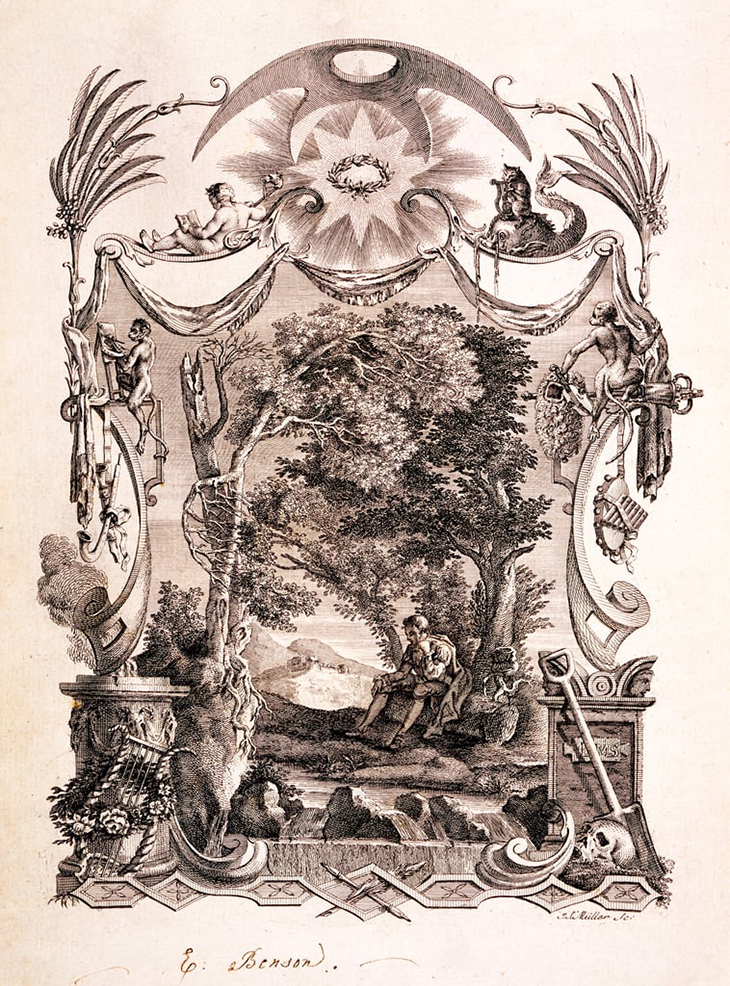
Plate by Richard Bentley, from Designs by Mr. R. Bentley, for Six Poems by Mr. T. Gray (1753)
The tradition of illustrating Gray’s ‘Elegy’ begins with the poet’s schoolmate at Eton, the gossip and bon vivant Horace Walpole. Walpole hired Richard Bentley, an architectural designer who sat on the Committee of Taste for Walpole’s extravagant gothic mansion, to draw up some plate designs for six of his old friend’s poems. In answer to the brief, Bentley addressed the poem in a neoclassical register. Nowhere more pronouncedly so than at the end of the poem, as the speaker imagines what will happen to him after his own death: the mourners coming ‘with dirges due in sad array’, and the famous ‘Epitaph’ that closes the poem. Bentley’s illustration here depicts the funeral scene, and beneath, he shows us the cross-section of an ornate, vaulted crypt. It’s an apt visual demonstration of the contradictions Gray sought to reconcile in verse – rustic subject matter and high poetic craft – reminding us that peasants and nobility share the same fate.
Gray was ambivalent about Bentley. ‘Heaven forbid they should suspect it to belong to any verses of mine,’ he complained to Walpole, ‘they would burn me for a poet.’ But elsewhere, he wrote rapturously of the artist: ‘Half pleas’d, half blushing let the muse admire, / While Bentley leads her sister-art along…’ In the end, Gray Bentley’s images were published under the title Designs by Mr. R. Bentley, for Six Poems by Mr. T. Gray, a wording that seems to remove himself from the spotlight. ‘I desire it may be understood,’ Gray begged of the publisher, ‘that the Verses are only subordinate, & explanatory to the Drawings.’
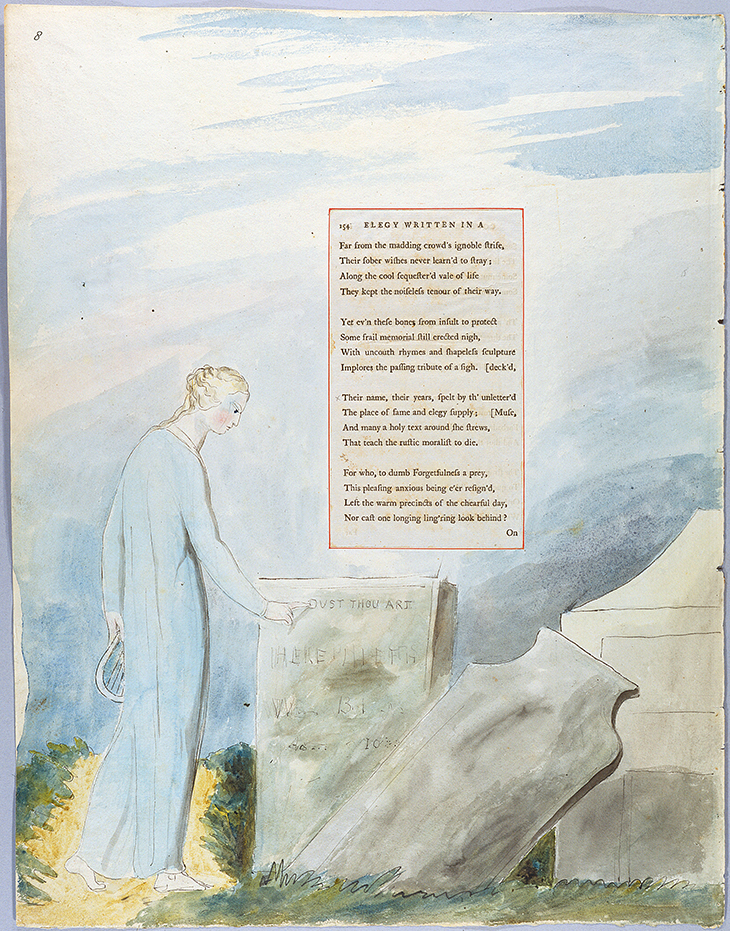
Page from The Poems of Thomas Gray (1797–98), William Blake
At the close of the century, the artist John Flaxman commissioned William Blake for an edition of Gray’s works in watercolour. Flaxman wanted one as much to delight his wife as to provide some work for his friend, who in 1798 was in a bit of a rut. Blake cut up Anne Flaxman’s copy of the collected poems and pasted its pages on the centre of folio sheets. For the most part, the paintings he created around them are as ecstatic as one might expect from Blake – but when it comes to the ‘Elegy’, Blake reigns himself in. The colours are muted; the compositions grounded by fixed horizons throughout. He does, however, take the liberty of inserting himself in the poem. Beneath the lines in which Gray’s speaker begins to reflect upon the faded inscriptions on the headstones (‘Their name, their years, spelt by th’unletter’d Muse, / The place of fame and elegy supply’) Blake depicts his own epitaph: ‘DUST THOU ART HERE LIETH WM BLAKE’, anticipating Gray’s own trick at the close of the poem.
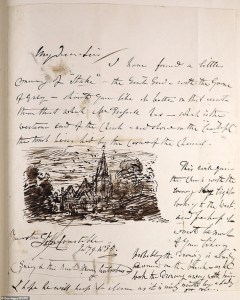
Letter from John Constable to his publisher John Martin, including an ink sketch of the churchyard at Stoke Poges (1835)
By the time Constable came to the poem, the graveyard of St Giles Church in Stoke Poges – though Gray denied it, the alleged setting of the poem, where Gray’s beloved aunt was buried, and where the poet joined her in 1771 – had become something of a site of pilgrimage. As he began work on his vignettes for an 1836 edition of the ‘Elegy’, Constable travelled there himself – and his frontispiece faithfully reproduces the dramatic front entrance to St. Giles (although a gothic note is introduced with bats and a full moon). Last year, a letter was discovered in which Constable offers his editor an alternative angle, showing the cemetery where the poem’s action (scholars claimed) was more likely to have taken place. ‘This will give the church with the evening light looking to the west and perhaps it would be much to your liking.’ He encloses an ink sketch and circles two spots: ‘Grey & his Aunt Mary Antrobus.’ His documentarian urge was shared by subsequent generations; at the close of the 19th century Dr James Leon Williams, the New York dentist who discovered the corrosive effects of plaque, set out with his camera on a tour of Stoke Poges, and published an album in honour of ‘the most widely known classic in the English language’.
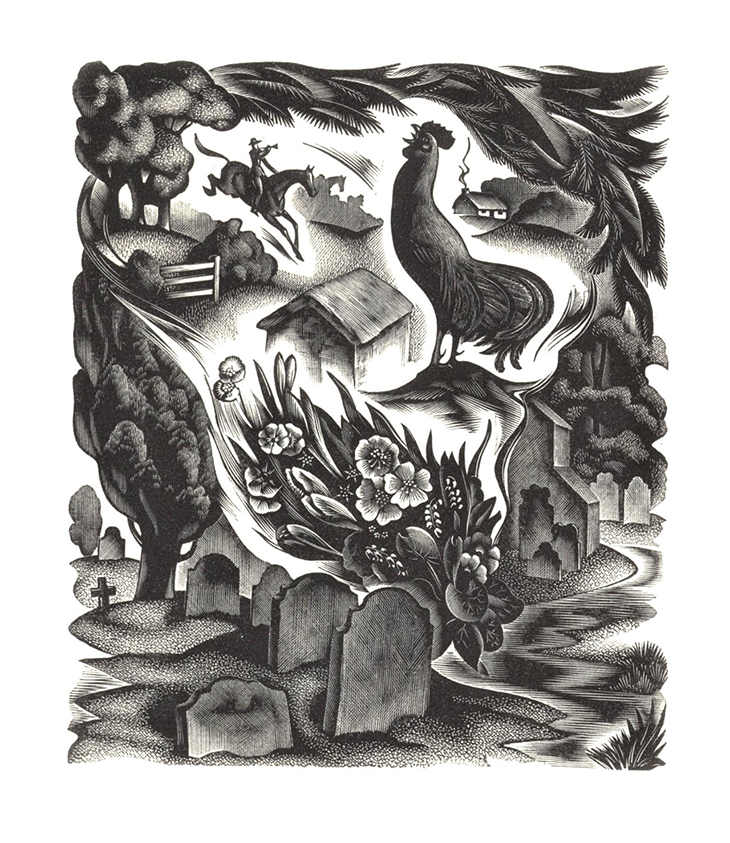
Illustration for Elegy Written in a Country Churchyard (1938), Agnes Miller Parker
The 20th century brought a host of modern interpretations – from the high deco of John Vassos’s gouaches in 1931, printed with the novel Knudsen process that used vacuumed celluloid, to the white-line engravings of Gwenda Morgan in 1948. For a new edition published last year, in honour of the 250th anniversary of the poet’s death, the Bodleian Library in Oxford reprinted the voluptuous woodcut landscapes of Agnes Miller Parker. Originally published in 1938, Parker’s woodcuts are at once homespun and mystical to a degree that even Blake didn’t manage.
Since Gray’s own time, countless illustrators have sought to create a concrete world for his most celebrated poem. But perhaps his most faithful interpreter is one of his most recent and certainly his most abstract. If you manage to get your hands on one of 20 copies of the Surrey-born book-designer Susan Allix’s edition of 1997, you’ll find it bound in black goatskin and containing a peculiar inlay. A tiny engraved glass window allows you to peer through the leather cover into purple Japanese endpapers within. Inside are 17 enchanting prints; here, the verses explain the plates as much as vice versa. Gray’s description of the ‘breezy call of incense-breathing morn’ is rendered, aptly, in soft-ground etching. Other plates are inked à la poupée (with all colours at once), suggesting the poetic imagination taking flight into Gray’s ‘gem of purest ray serene’.
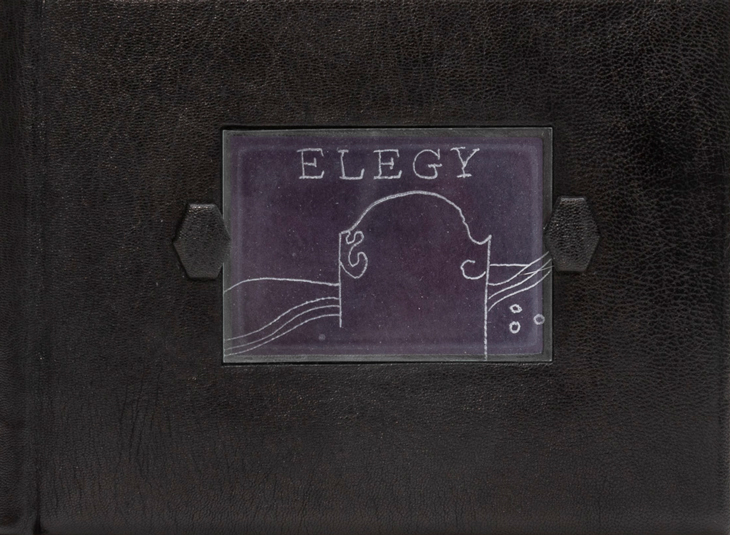
Cover for Lines from Elegy written in a country churchyard; with etchings drawn in Sussex churchyards by Susan Allix (1997). Photo: Ben Blossom
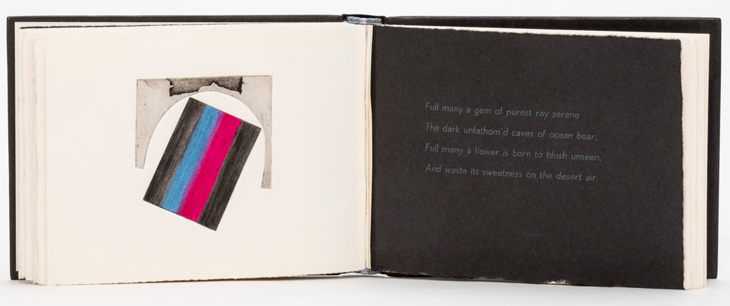
Pages from Lines from Elegy written in a country churchyard; with etchings drawn in Sussex churchyards by Susan Allix (1997). Photo: Ben Blossom
The variety of Allix’s printing methods, and the depth of her abstractions, remind us that Gray’s greatest success was not to memorialise a particular cemetery, but to represent the wanderings of the nocturnal mind, at its most susceptible and its most vulnerable, overwhelmed by a silent piece of earth.
Elegy Written in a Country Churchyard, with wood engravings by Agnes Miller Parker, is published by Bodleian Libraries.
Unlimited access from just $16 every 3 months
Subscribe to get unlimited and exclusive access to the top art stories, interviews and exhibition reviews.


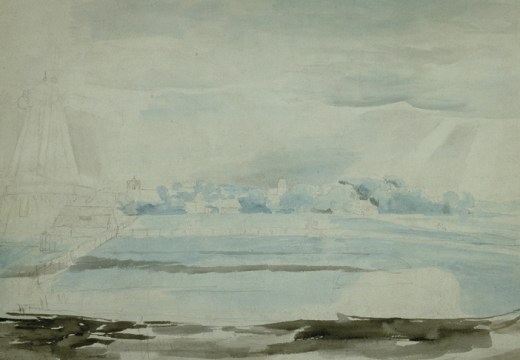
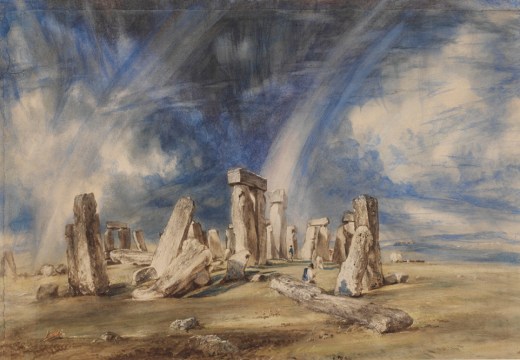










![Masterpiece [Re]discovery 2022. Photo: Ben Fisher Photography, courtesy of Masterpiece London](http://www.apollo-magazine.com/wp-content/uploads/2022/07/MPL2022_4263.jpg)
It’s time for the government of London to return to its rightful home